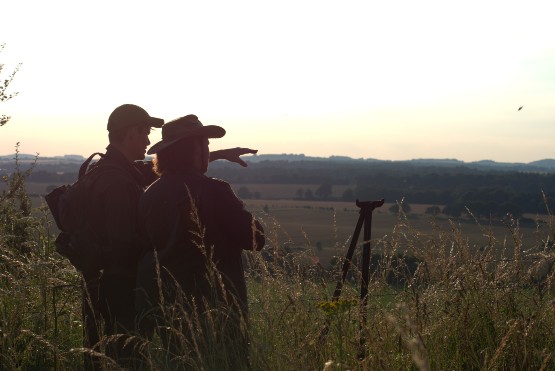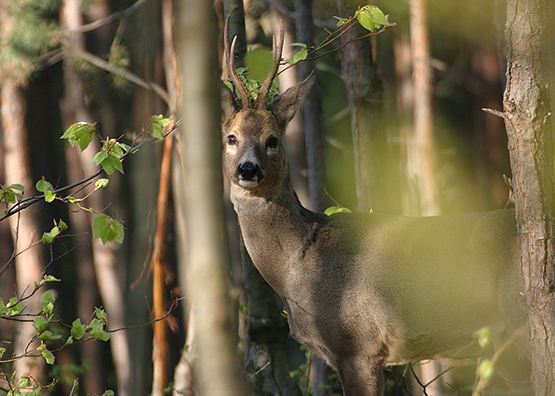Jonty Drew considers how best way to manage Roebuck in order to minimise damage to trees.
I place my back against an ancient English oak, staying deathly still, waiting for the woodland to adjust to my presence. I find myself imagining the stories this tree could tell, the secrets it could hold and the people it could have met in generations gone. This reminds me of my Father’s favourite Dorset poet, William Barnes and his poem ‘The Gre’t Woak Tree’.

With my presence accepted, I stalk deeper into the woods, scanning and listening for the faintest sign of movement, when my senses alert me to the appearance of a regal-looking roebuck. He holds his territory with nobility and devotion and whilst I gaze in awe at his silvery face and flawless head, he starts fraying at a sapling oak, removing the last strands of his bothersome velvet and discouraging those who wish to challenge his reign.
This is a common occurrence in woodlands that have roe deer present and is vital for the social development and structure of the species. One might see this buck as an animal to cull for its wall-mounting and storytelling opportunity, but if you delve into the behaviour of these native wonders, you find a greater reason to leave him be, for now at least.
When establishing and holding their territories, roebuck will usually fray at various sapling trees to leave scent marks and to remove their velvet. If sapling trees are scarce or deer density is too high, then mature trees will be targeted out of necessity. Through secretion from their forehead and preorbital glands, scent marking is a way of communicating through pheromones, the dominance of a territory to rival bucks, and a way of attracting does into the territory ready for the rut to begin mid-July. Although scent marking can occur through various glands, the mentioned glands are specifically used for scent marking during fraying. While fraying is a significant social behaviour, it can have detrimental effects on trees by triggering fungal infections, leading to fungal decay, wind breakage, and ultimately, premature death.

So how, might you ask, can a roebuck be such a compelling tree protector if fraying is a necessary activity for territory establishment and velvet removal? It’s about overall impact.
Roebucks start to establish and hold their territories from the end of March all the way through to around November, when their testosterone levels have significantly dropped and their browsing decreases due to a reduction in their metabolic rate. If their territory happens to contain a woodland, it will be ardently guarded throughout this time by the dominant buck and thus the trees within the territory will only be frayed by him, within reason.
If we now remove the dominant buck and create a territorial void, the other bucks, that have not yet established their own territory’s will compete for this area, causing a rise in the number of bucks present in the woodland and therefore the inevitable increase in fray damage. With an educated guess, this could cause anywhere between two and five times more damage, depending on the size of woodland and the current deer density. Therefore, keeping the dominant buck provides protection for the trees present in his territory, as the damage impact caused is considerably less compared to if the area is being competed for by multiple bucks.
As deer managers, we need to take time and care to understand the social behaviour and complexities of our deer to orchestrate a cull plan that is tailored to benefit their population, genetic strength and the environment. Getting to know the roe bucks on your ground and their territories makes the management more selective and is imperative to creating a healthy population. Furthermore, the knowledge and wisdom passed down through generations of deer managers can help us to understand and implement small changes that have a profound impact on the population, benefits the environment and makes our job less challenging.
Obviously, the succession of the aforementioned regal roebuck is inevitable, as he will succumb to age, making him vulnerable to stresses caused by pressures of the younger dominant bucks. Eventually capitulating, he will find himself without a territory and move on to pastures new. This, in my opinion, would be the opportune moment to cull this animal, as his health will start to deteriorate and out of respect, give him the swift departure that he deserves, compared to mother nature’s arguably undignified end. Eventually, a new dominant buck will prevail in his stead and his territory and the trees within will be secured. May this cycle continue in perpetuity.
Ultimately, understanding the behaviour and ecology of our wonderful wildlife allows us to better manage them for the species and the wider environment. It will always be hard to find a definitive answer, as there are always uncontrollable elements to navigate, but I encourage you to take the time to converse with as many deer and wildlife managers as possible, to help create an arsenal of knowledge that you can implement in the field which hopefully leads to positive results.
 Jonty Drew is a PDS1 Approved Verifier in Deer Stalking Qualifications, DMQ Approved Witness, and experienced stalking guide. He holds an Extended Diploma in Countryside Management, Game & Wildlife from Sparsholt College with distinction and is currently working towards a BSc in Wildlife Conservation and Environmental Management at the prestigious 'Harper Adams University'.
Jonty Drew is a PDS1 Approved Verifier in Deer Stalking Qualifications, DMQ Approved Witness, and experienced stalking guide. He holds an Extended Diploma in Countryside Management, Game & Wildlife from Sparsholt College with distinction and is currently working towards a BSc in Wildlife Conservation and Environmental Management at the prestigious 'Harper Adams University'.
With more than a decade of experience in the industry, Jonty has had the privilege to train and mentor numerous individuals in achieving their various deer management & stalking qualifications.
If you'd like to go Roebuck stalking then contact us on: 0203 981 0159 or email:
For more on Roebuck Stalking follow this link: roebuck-stalking-everything-you-need-to-know



















